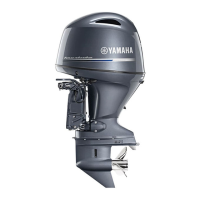Maintenance
88
perform a maintenance procedure, have a
Yamaha dealer or other qualified mechan-
ic do the work.
The procedures involve disassembling
the motor and exposing dangerous parts.
To reduce the risk of injury from moving,
hot, or electrical parts:
●
Turn off the engine and keep the key(s)
and engine shut-off cord (lanyard) with
you when you perform maintenance un-
less otherwise specified.
● The power trim and tilt switches operate
even when the ignition key is off. Keep
people away from the switches whenev-
er working around the motor. When the
motor is tilted, keep away from the area
under it or between it and the clamp
bracket. Be sure no one is in this area
before operating the power trim and tilt
mechanism.
● Allow the engine to cool before handling
hot parts or fluids.
●
Always completely reassemble the mo-
tor before operation.
Maintenance, replacement, or repair of the
emission control devices and systems
may be performed by any marine engine
repair establishment or individual. All war-
ranty repairs, however, including those to
the emission control system, must be per-
formed by an authorized Yamaha marine
dealership.
A service manual is available for purchase
through your Yamaha dealer for owners who
have the mechanical skills, tools, and other
equipment necessary to perform mainte-
nance not covered by this owner’s manual.
EMU28511
Replacement parts
If replacement parts are necessary, use only
genuine Yamaha parts or parts of equivalent
design and quality. Any part of inferior quality
may malfunction, and the resulting loss of
control could endanger the operator and pas-
sengers. Yamaha genuine parts and acces-
sories are available from your Yamaha
dealer.
EMU35521
Maintenance interval guidelines
The service intervals provided in the Mainte-
nance Chart were developed based upon
“typical” use that includes operating at varied
speeds, with sufficient time for engine warm
up and cool-down, a medium to light load, and
an average cruising speed near the 3000 to
4000 rpm range. As with any engine, howev-
er, if your normal operating conditions are dif-
ferent, you should consider service more
often than shown, especially how often you
change your engine oil and gear oil. Exam-
ples might include extended wide-open-throt-
tle use or long periods of trolling or idling,
carrying heavy loads, or frequent starting and
stopping or shifting. More frequent mainte-
nance will often pay off many times over in in-
creased engine life and greater owner
satisfaction. Consult your Yamaha dealer for
additional maintenance recommendations.
U63P1DE0.book Page 88 Tuesday, March 29, 2011 7:15 PM
©2019 Yamaha Motor Corporation, U.S.A.

